In the vast landscapes of Arizona, from its sweeping deserts to its towering pines, lies an often-overlooked gem: a plethora of blue-hued birds. These avian wonders, with their mesmerizing shades of azure, cerulean, and cobalt, grace the state with their presence, making it a birdwatcher’s paradise.
With our comprehensive guide on ‘Blue Birds In Arizona,’ you’re invited to embark on a visual journey into the heart of this avian splendor. Paired with a free photo guide, it’s an experience that brings the vibrant blues of Arizona’s birds right to your fingertips.
Blue Birds Found In Arizona
Arizona’s varied geography, from its arid Sonoran Desert to the lush coniferous forests of the high country, provides a myriad of habitats for a rich tapestry of bird species.
The state’s unique position, where southern desert meets northern temperate zones, has given rise to an impressive array of avian diversity. This mosaic of terrains and climates offers nesting, feeding, and migratory stopover points for countless bird species, including the mesmerizing blue birds in Arizona.
Western Bluebird
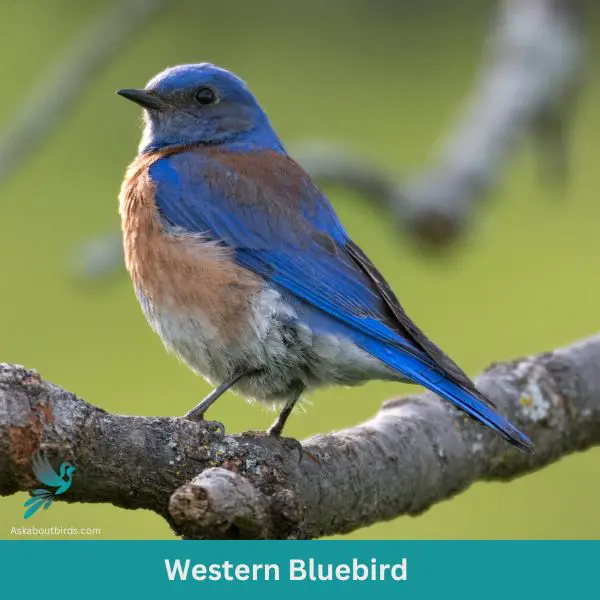
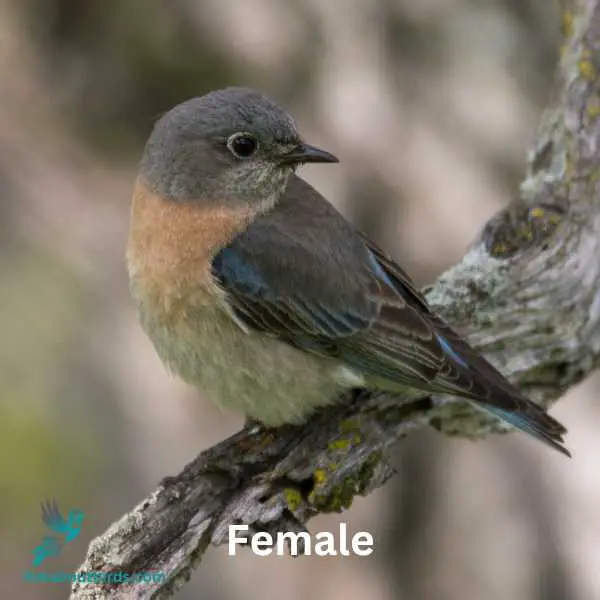
| Trait | Western Bluebird |
|---|---|
| Scientific Name | Sialia mexicana |
| Length | 5.5-7 inches |
| Wingspan | 11-13 inches |
| Weight | 0.8-1.1 ounces |
The Western Bluebird is a charismatic bird, appreciated for its vivid coloring and melodious song, commonly observed in open woodlands and meadows of the West.
Appearance: The male Western Bluebird sports a dark blue head, throat, wings, and tail with an orange breast and sides, transitioning into a grayish belly. Females are more muted, displaying grayish-blue wings and tail with a more subdued orange wash on the chest.
Diet: Western Bluebirds predominantly feed on insects, complemented by berries and fruits when available. They hunt by perching and then diving to the ground to capture their prey, and they’re also known to catch insects in mid-air.
Reproduction: These birds often utilize natural tree cavities or nest boxes for breeding. The female builds a loose nest inside and lays a clutch of 4-6 pale blue eggs.
Mountain Bluebird
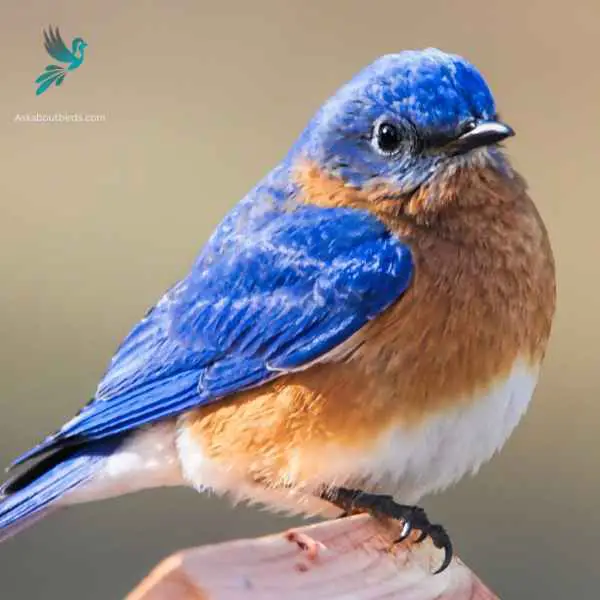
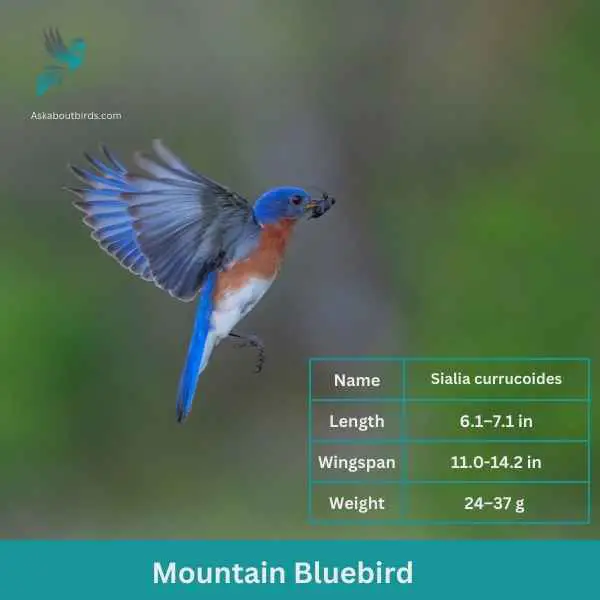
| Feature | Measurement |
|---|---|
| Scientific Name | Sialia currucoides |
| Length | 6.1–7.1 in |
| Wingspan | 11.0-14.2 in |
| Weight | 24–37 g |
The Mountain Bluebird is a small bird found in open grasslands and rocky mountains of North America. It is known for its stunning blue plumage, which is particularly vibrant in males. Females, on the other hand, have a more subdued blue coloration with hints of gray. These birds have slender bodies and a slightly curved bill, adapted for catching insects on the wing.
Mountain Bluebirds are insectivores, feeding primarily on insects such as beetles, grasshoppers, and spiders. They are skilled aerial hunters, capable of capturing their prey in mid-flight. During breeding season, these birds build their nests in tree cavities or man-made nest boxes, where females lay a clutch of eggs. The male bluebird actively participates in nest-building and provides food for the female during incubation.
Eastern Bluebird
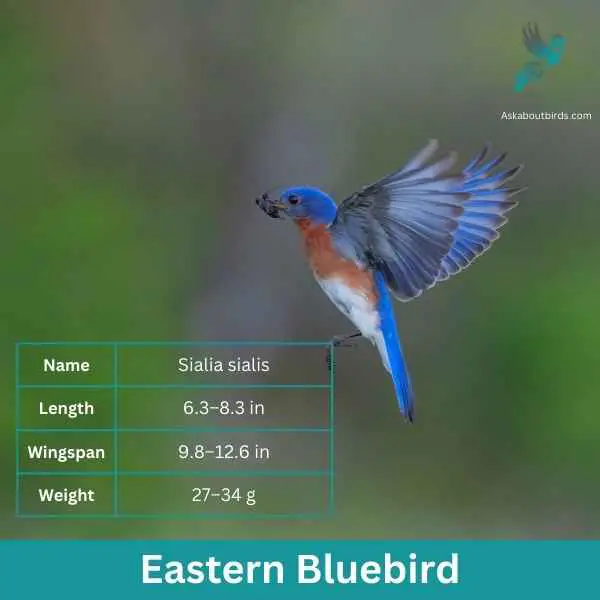
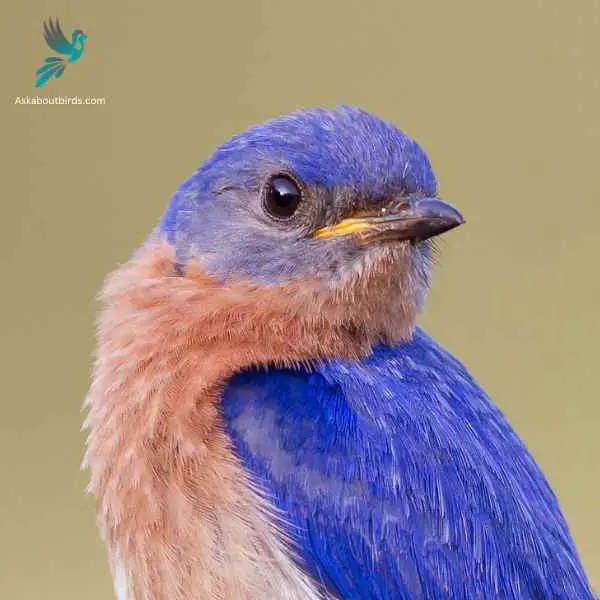
| Feature | Measurement |
|---|---|
| Scientific Name | Sialia sialis |
| Length | 6.3–8.3 in |
| Wingspan | 9.8–12.6 in |
| Weight | 27–34 g |
The Eastern Bluebird (Sialia sialis) is a small thrush found in open woodlands, farmlands, and orchards, and is recognized for its vibrant blue and red coloration. Male Eastern Bluebirds are dazzling with bright blue upperparts and a rusty or brick-red throat and breast, while females, though less colorful, still offer a similar pattern. The bird is native to North America and is commonly seen east of the Rockies, from Canada to the Gulf States and southeastern Arizona to Nicaragua.
Eastern Bluebirds feed on insects, wild fruit and berries. They have a gentle nature and are often seen perched alone or in small groups in the open, scanning the ground for prey. They are cavity nesters and will use old woodpecker holes or birdhouses if they are the right size.
Blue Grosbeak
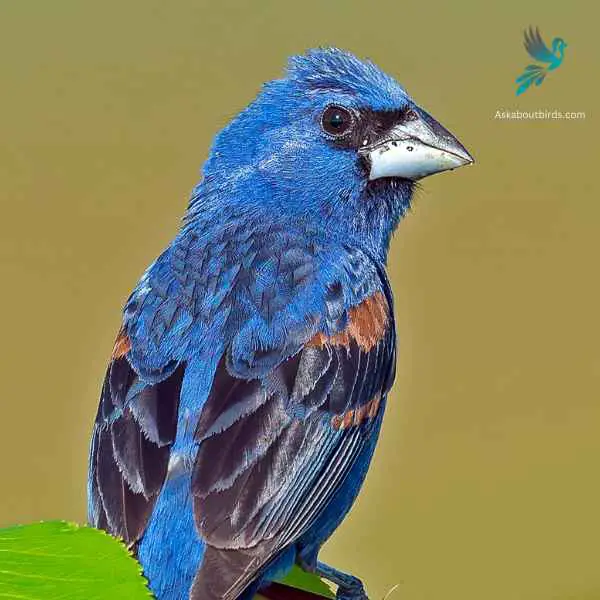
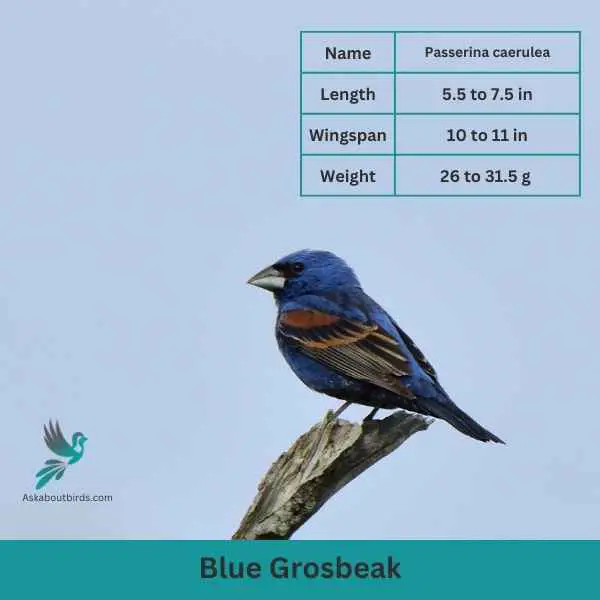
| Feature | Measurement |
|---|---|
| Scientific Name | Passerina caerulea |
| Length | 5.5 to 7.5 in |
| Wingspan | 10 to 11 in |
| Weight | 26 to 31.5 g |
The Blue Grosbeak is a medium-sized songbird found in North and Central America. The male Blue Grosbeak displays stunning plumage with deep blue feathers on its body and head, while the female has more subdued brownish tones. Both sexes have a thick, conical bill, which gives them their name “grosbeak,” meaning large beak.
These birds prefer open habitats such as grasslands, brushy areas, and woodland edges. Blue Grosbeaks are known for their melodious songs, which consist of a series of rich and varied notes. They primarily feed on seeds and insects, using their strong beaks to crack open seeds and forage on the ground or in low vegetation.
Indigo Bunting


| Feature | Measurement |
|---|---|
| Scientific Name | Passerina cyanea |
| Length | 4.5–5.1 in |
| Wingspan | 7.1–9.1 in |
| Weight | 11.2–21.4 g |
The Indigo Bunting is a strikingly vibrant songbird, often hailed for its brilliant blue plumage and melodic song that graces woodlands and meadows during the warmer months.
Appearance: Males are renowned for their bright indigo blue feathers, which can appear darker in certain lights. Females and juveniles, on the other hand, are brown with subtle hints of blue on their wings and tail. The species lacks the vibrant streaking or spotting commonly found in many other songbirds.
Diet: Indigo Buntings primarily subsist on seeds, especially during non-breeding seasons. During the breeding season, they also consume a variety of insects such as beetles, caterpillars, and spiders, providing essential protein for their growing chicks.
Reproduction: Indigo Buntings build their nests close to the ground in shrubs or low tree branches. These nests, crafted meticulously with grasses and other plant materials, cradle clutches of typically 3 to 4 eggs. After hatching, the young are fed by both parents until they’re ready to fledge.
Lazuli Bunting
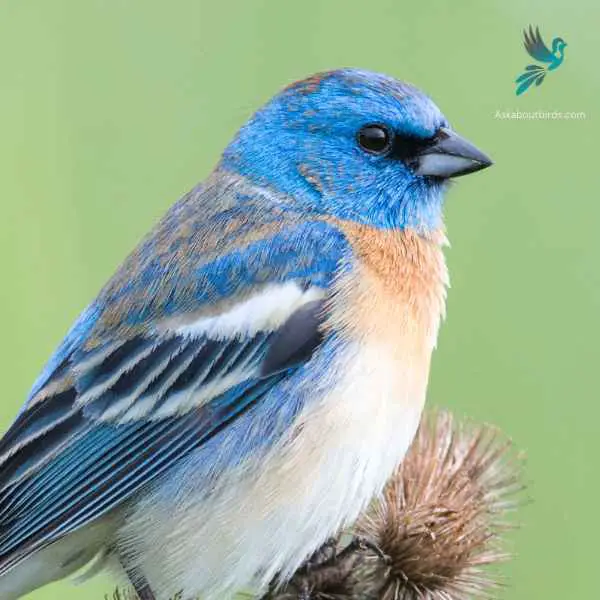
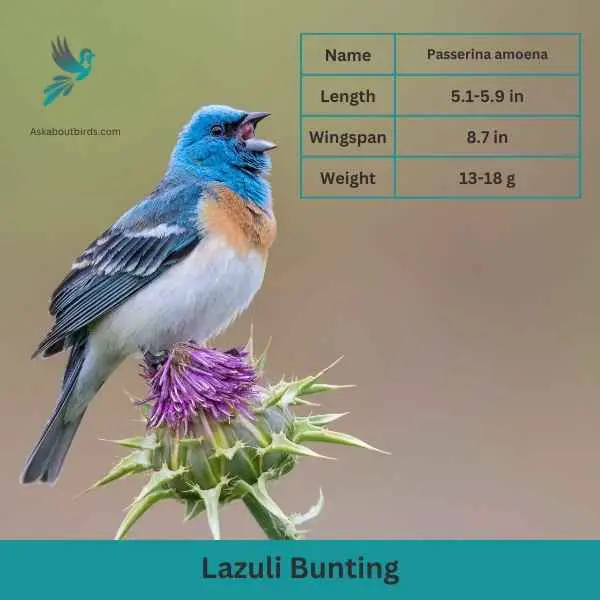
| Feature | Measurement |
|---|---|
| Scientific Name | Passerina amoena |
| Length | 5.1-5.9 in |
| Wingspan | 8.7 in |
| Weight | 13-18 g |
The Lazuli Bunting is a vibrant songbird recognized for its brilliant colors and melodious song, frequently seen in brushy areas and woodlands during the summer months.
Appearance: The male boasts a dazzling bright blue head and back, offset by a white belly and rust-orange breast. Females and immature birds present a more muted brownish hue overall, with a hint of blue on the wings and tail.
Diet: Lazuli Buntings primarily feed on seeds, but during the breeding season, they’ll also consume insects. Their strong, conical beaks are perfectly adapted for seed-cracking.
Reproduction: The female Lazuli Bunting constructs a cup-shaped nest using grasses, twigs, and other fine materials, often placing it in a shrub or low tree. She typically lays a clutch of 3-4 pale blue or white eggs.
Mexican Jay
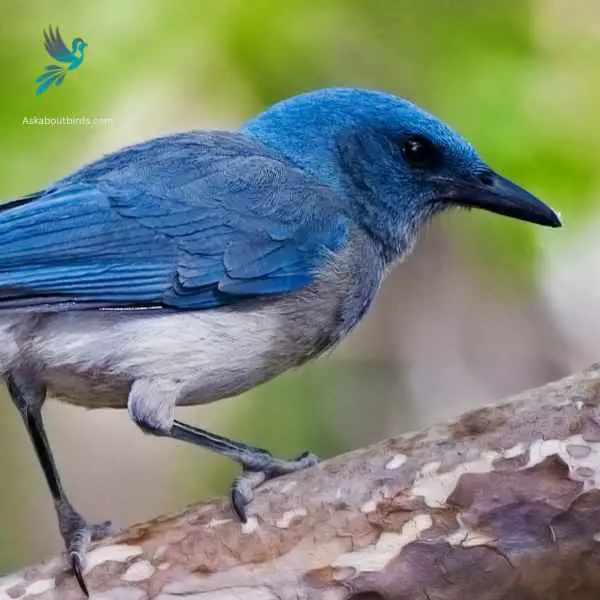
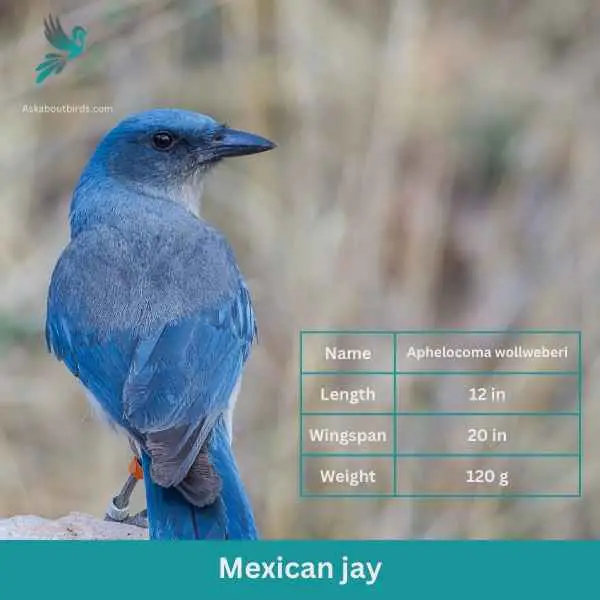
| Feature | Measurement |
|---|---|
| Scientific Name | Aphelocoma wollweberi |
| Length | 12 in |
| Wingspan | 20 in |
| Weight | 120 g |
The Mexican Jay, native to the southwestern United States and Mexico, is a charismatic and intelligent bird known for its vibrant appearance and social behavior. With a striking combination of blue, black, and white feathers, it stands out amidst the arid landscapes it inhabits. Mexican Jays are medium-sized birds with a robust build and a crest on their head, adding to their distinctive charm.
These birds are highly social and often form large flocks that engage in cooperative behaviors such as mobbing predators or foraging together. They have a wide-ranging diet, including seeds, fruits, insects, and even small vertebrates. Mexican Jays are also known for their remarkable vocalizations, which consist of a variety of calls, including raucous squawks and melodious notes.
Pinyon Jay
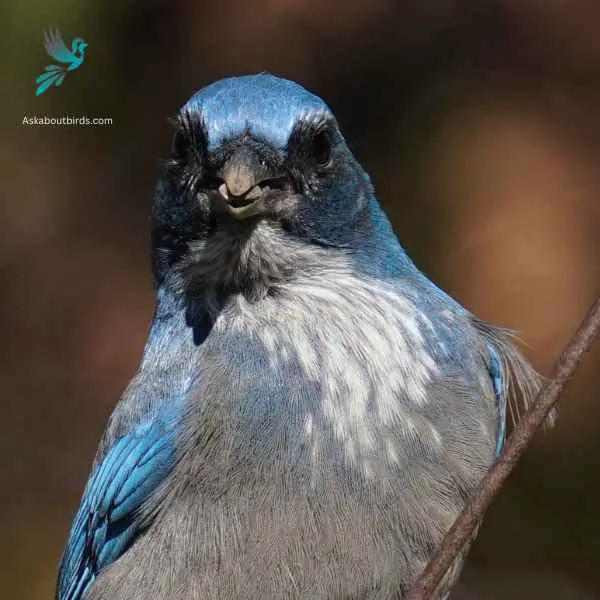
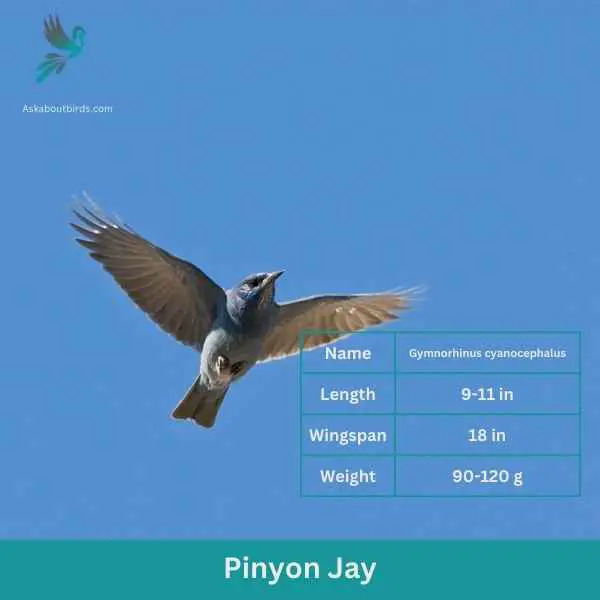
| Feature | Measurement |
|---|---|
| Scientific Name | Gymnorhinus cyanocephalus |
| Length | 9-11 in |
| Wingspan | 18 in |
| Weight | 90-120 g |
The Pinyon Jay is a small, stout bird found in the western United States and Mexico. It has a distinctive blue-gray coloration with a black head and neck. The bird is well adapted to living in dry, arid habitats with sparse vegetation and can often be found in pinyon pine and juniper forests. The Pinyon Jay is known for its communal behavior, living in groups of up to several hundred birds during the non-breeding season. During breeding season, they form monogamous pairs and build nests in juniper trees.
The Pinyon Jay’s diet consists mainly of pinyon pine seeds, but they also eat insects, berries, and other seeds. They have a unique way of storing food for later, using their expandable throat pouch to carry up to 50 seeds at once. The Pinyon Jay is an important seed disperser for pinyon pine and juniper trees, and is a vital part of the ecosystem in its range. However, habitat loss and fragmentation due to human activities, such as logging and oil and gas development, have led to declines in Pinyon Jay populations in recent years.
Steller’s Jay
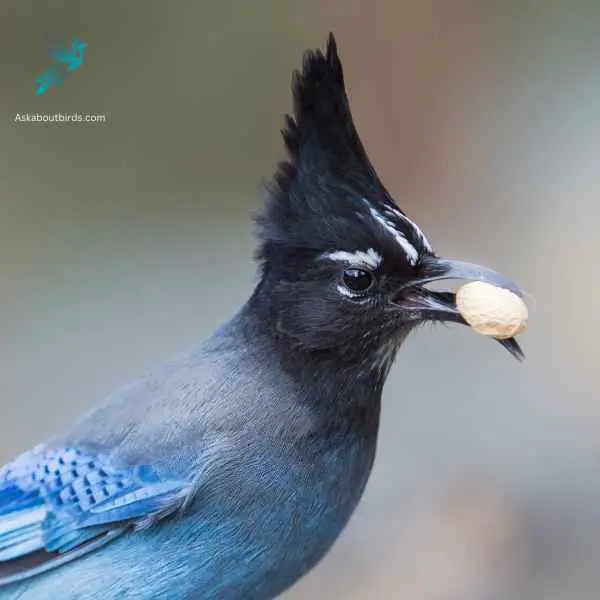
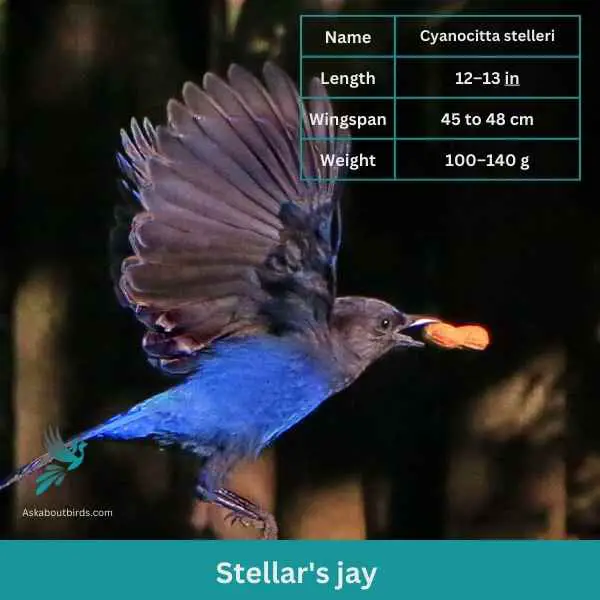
| Feature | Measurement |
|---|---|
| Scientific Name | Cyanocitta stelleri |
| Length | 12–13 in |
| Wingspan | 45 to 48 cm |
| Weight | 45 to 48 cm |
The Steller’s Jay is a charismatic and easily recognizable bird found mainly in the coniferous forests of the western North America, known for its bold behavior and loud, varied calls.
Appearance: The Steller’s Jay has a striking color contrast with a deep blue body and wings and a blackish head and upper body. One of its most distinguishing features is the tall, dark crest on its head, which can be raised or lowered depending on the bird’s mood. Its eyes are dark and its beak is strong and black.
Diet: The Steller’s Jay is omnivorous. It feeds on a wide range of items, from seeds, nuts, and berries to insects and small animals. It’s also known to raid campsites and picnics, often scavenging for human food.
Reproduction: Steller’s Jays form monogamous pairs that often remain together for several years. They typically build their nests in coniferous trees, made from twigs, moss, and other plant materials. The female lays a clutch of 2 to 6 eggs, which are usually pale green or blue with brown spots.
Common Grackle
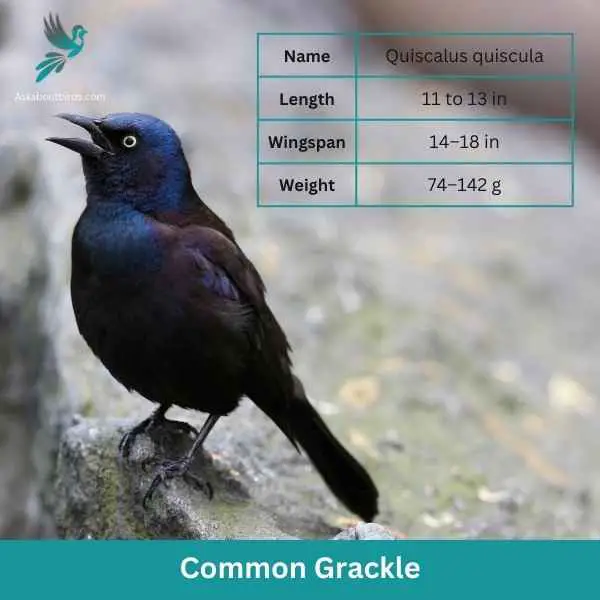
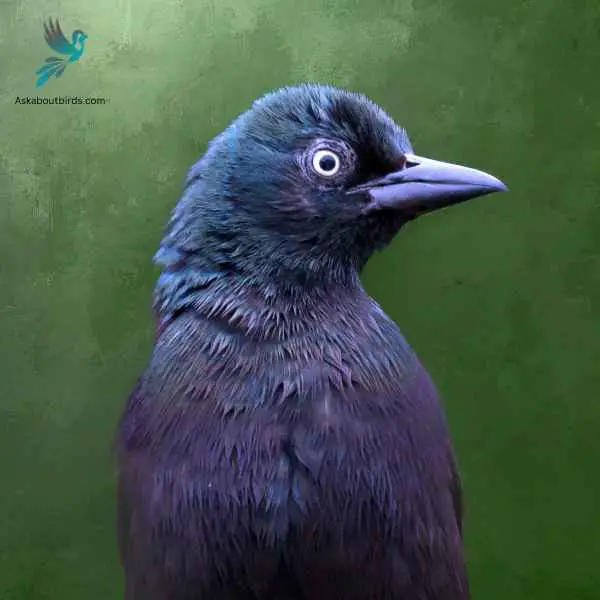
| Feature | Measurement |
|---|---|
| Scientific Name | Quiscalus quiscula |
| Length | 11 to 13 in |
| Wingspan | 14–18 in |
| Weight | 74–142 g |
The Common Grackle is a conspicuous bird found across much of North America, recognized for its glossy-black plumage, long tail, and piercing yellow eyes. Its vocalizations are varied and include a range of harsh, grating calls.
Appearance: The Common Grackle has a sleek black body with a glossy-iridescent sheen that can appear purple, green, or blue in certain lights. Its tail is long and keel-shaped. While both males and females have similar coloration, males are noticeably larger and shinier than females.
Diet: Common Grackles are omnivores. They primarily consume seeds, berries, and insects. However, they are also known to eat small fish, amphibians, and other birds’ eggs, especially when foraging on the ground or in shallow water.
Reproduction: Common Grackles breed in open and semi-open areas. The female typically selects the nest site and constructs a bulky nest made of grasses, twigs, and other plant materials, often in shrubs or trees. She lays a clutch of about 1 to 7 eggs, which are pale blue and spotted with brown.
Western Scrub-Jay
| Scientific Name | Length | Wingspan | Weight |
|---|---|---|---|
| Aphelocoma californica | 11-12 inches | 15 inches | 2.8-3.5 oz. |
The Western Scrub-Jay is a distinctively colored bird known for its bright blue and grey plumage, often seen hopping through low vegetation or perched high on tree branches.
Appearance: This bird has a striking blue head, wings, and tail that contrast vividly with its gray-brown back and pale gray underparts. A standout feature is the blue necklace or collar separating its head from the body.
Diet: Western Scrub-Jays primarily consume seeds, nuts (especially acorns), fruits, and insects. They are known to store surplus food in hidden caches to retrieve later.
Reproduction: Western Scrub-Jays form monogamous pairs that build open cup-shaped nests in trees or shrubs. The female typically lays between 3 to 6 eggs, which she incubates while the male helps in feeding and defending the territory.
Blue-throated Mountain-gem
| Scientific Name | Length | Wingspan | Weight |
|---|---|---|---|
| Lampornis clemenciae | 4.5 inches | 6.7 inches | 0.3-0.4 oz. |
The Blue-throated Mountain-gem is a radiant and dazzling hummingbird, celebrated for its vivid colors and rapid flight patterns often observed in mountainous regions.
Appearance: This hummingbird is notable for its gleaming blue throat, a color that contrasts strikingly with its green upperparts and white underparts. Males are generally more vibrant than females, with the latter often displaying a more subdued color palette with shades of gray.
Diet: Blue-throated Mountain-gems primarily subsist on nectar from a variety of flowering plants. They have a fondness for tubular flowers, which are easily accessible with their long, specialized bills. Insects and spiders are also occasionally part of their diet for protein.
Reproduction: These birds make their nests on horizontal branches, usually suspended under large leaves or overhanging shelters to remain hidden from predators. The female typically lays 2 eggs, incubating them herself. During this period, she is frequently fed by the male.
Where to Spot Arizona’s Blue Birds
Arizona’s multifaceted terrains have made it a top destination for bird enthusiasts. After many years of traversing its landscapes in search of the captivating blue birds and their avian counterparts, here are my top picks for the best birdwatching locales in the state:
- Madera Canyon
Nestled within the Santa Rita Mountains, Madera Canyon is a hotspot for birders. With over 250 species recorded, it’s particularly known for hummingbirds but also showcases a variety of blue birds. - Patagonia-Sonoita Creek Preserve
A vital oasis in the desert, this preserve is a haven for rare species. The mix of riparian habitats and cottonwood-willow forests attracts both migratory and resident blue birds. - San Pedro Riparian National Conservation Area
Encompassing the San Pedro River, this area boasts over 400 bird species. The river’s life-giving waters draw in an abundance of avian life, including several species of blue birds. - Ramsey Canyon Preserve
Located in the Huachuca Mountains, the cool streams and high elevation forests of Ramsey Canyon are perfect for spotting diverse bird species, including the vibrant blue-throated mountain-gem. - Chiricahua Mountains
This sky island is a crossroads of bird ranges, and its unique habitats house both eastern and western bird species, offering birdwatchers an eclectic mix, with blue birds being a frequent sight.
| State’s Blue birds | Top Spots for Blue Birds |
|---|---|
| California’s Blue birds | 1. Point Reyes National Seashore 2. Big Sur 3. Sequoia and Kings Canyon National Parks |
| Nevada’s Blue birds | 1. Great Basin National Park 2. Red Rock Canyon 3. Ruby Mountains |
| Utah’s Blue birds | 1. Bryce Canyon National Park 2. Bear River Migratory Bird Refuge 3. Zion National Park |
| New Mexico’s Blue birds | 1. Bosque del Apache National Wildlife Refuge 2. Gila National Forest 3. Valles Caldera National Preserve |
| Colorado’s Blue birds | 1. Rocky Mountain National Park 2. Mesa Verde National Park 3. San Juan Mountains |
FAQs on Blue Bird Species Found in Arizona
What are the characteristics of blue colored birds that are commonly seen at bird feeders?
Blue colored birds are a sight to behold, especially when they visit bird feeders. Birds such as the blue jay, with its striking dark blue body and white throat, are regular visitors. The light blue of tree swallows is another captivating hue, especially against the backdrop of a clear sky. Many bird enthusiasts also marvel at the azure beauty of the blue gray gnatcatcher. Having a bird feeder in your backyard can attract these vibrant species, turning your space into a bustling haven for blue colored bird enthusiasts.
How can one differentiate between large blue birds often seen in the wild?
Large blue birds are distinct in their appearance and habitats. The great blue heron, often spotted near water bodies, stands tall with a majestic blue hue. On the other hand, the belted kingfisher, recognizable with its sharp thin bill, is a frequent sight near water sources, diving for fish. The barn swallow, though smaller, is distinct with its deep blue body and flight pattern as it chases flying insects. Recognizing these birds and understanding their habitats can be a rewarding experience for birders and non-birders alike.
Which blue colored birds are primarily insectivorous?
Insectivorous blue colored birds play a pivotal role in controlling insect populations. The blue gray gnatcatcher, with its thin bill, is adept at catching small flying insects. Barn swallows, too, with their agile flight, predominantly feed on flying insects. Similarly, tree swallows, with their sky blue color, are often seen darting around to catch their insect prey. Observing these birds in action is a testament to nature’s intricate food web and the essential role these birds play in it.
Why are sunflower seeds popular in bird feeders for attracting blue colored birds?
Sunflower seeds are a favorite among many bird species, including blue colored birds. The nutrient-rich composition of these seeds makes them an excellent food source. Birds such as the blue jay are often attracted to bird feeders stocked with sunflower seeds, their dark blue bodies and white throats contrasting beautifully against the backdrop of the feeder. Offering sunflower seeds in backyard bird feeders can increase the chances of witnessing these blue beauties, turning any garden into a vibrant birdwatching hotspot.
